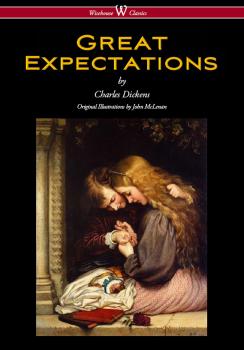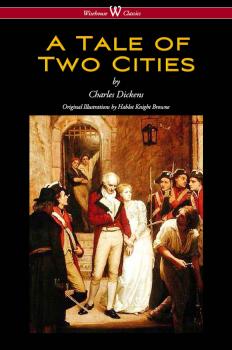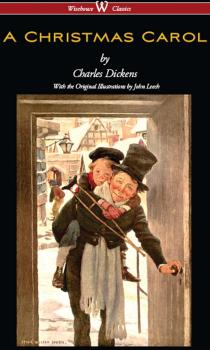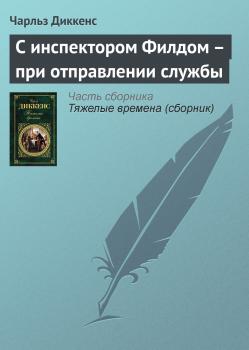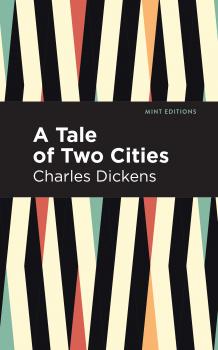Чарльз Диккенс
Список книг автора Чарльз ДиккенсGreat Expectations (Wisehouse Classics - with the original Illustrations by John McLenan 1860)
GREAT EXPECTATIONS is Charles Dickens' thirteenth novel and his penultimate completed novel; a bildungsroman which depicts the personal growth and personal development of an orphan nicknamed Pip. It is Dickens's second novel, after David Copperfield, to be fully narrated in the first person. The novel was first published as a serial in Dickens's weekly periodical All the Year Round, from 1 December 1860 to August 1861. In October 1861, Chapman and Hall published the novel in three volumes. It is set among marshes in Kent, and in London, in the early to mid-1800s, and contains some of Dickens' most memorable scenes, including the opening, in a graveyard, where the young Pip is accosted by the escaped convict, Abel Magwitch. GREAT EXPECTATIONS is full of extreme imagery -poverty; prison ships and chains, and fights to the death-and has a colorful cast of characters who have entered popular culture. Dickens's themes include wealth and poverty, love and rejection, and the eventual triumph of good over evil. GREAT EXPECTATIONS is popular both with readers and literary critics, and has been translated into many languages, and adapted numerous times into various media. Upon its release, the novel received near universal acclaim. Thomas Carlyle spoke disparagingly of «all that Pip's nonsense». Later, George Bernard Shaw praised the novel, as «All of one piece and consistently truthful.» During the serial publication, Dickens was pleased with public response to GREAT EXPECTATIONS and its sales; when the plot first formed in his mind, he called it «a very fine, new and grotesque idea.» (more on www.wisehouse-classics.com)
A Tale of Two Cities (Wisehouse Classics - with original Illustrations by Phiz)
A TALE OF TWO CITIES (1859) is a novel by Charles Dickens, set in London and Paris before and during the French Revolution. The novel depicts the plight of the French peasantry demoralized by the French aristocracy in the years leading up to the revolution, the corresponding brutality demonstrated by the revolutionaries toward the former aristocrats in the early years of the revolution, and many unflattering social parallels with life in London during the same period. It follows the lives of several characters through these events. A Tale of Two Cities was published in weekly installments from April 1859 to November 1859 in Dickens's new literary periodical titled All the Year Round. All but three of Dickens's previous novels had appeared only as monthly installments. With sales of about 200 million copies, A Tale of Two Cities is the bestselling novel in history. «It was the best of times, it was the worst of times, it was the age of wisdom, it was the age of foolishness, it was the epoch of belief, it was the epoch of incredulity, it was the season of Light, it was the season of Darkness, it was the spring of hope, it was the winter of despair, we had everything before us, we had nothing before us, we were all going direct to Heaven, we were all going direct the other way – in short, the period was so far like the present period, that some of its noisiest authorities insisted on its being received, for good or for evil, in the superlative degree of comparison only.»
A Christmas Carol (Wisehouse Classics - with original illustrations)
A CHRISTMAS CAROL is a novella by Charles Dickens, first published in London on December 1843. The novella met with instant success and critical acclaim. A Christmas Carol tells the story of a bitter old miser named Ebenezer Scrooge and his transformation into a gentler, kindlier man after visitations by the ghost of his former business partner Jacob Marley and the Ghosts of Christmas Past, Present and Yet to Come. The book was written at a time when the British were examining and exploring Christmas traditions from the past as well as new customs such as Christmas cards and Christmas trees. Carol singing took a new lease on life during this time. Dickens' sources for the tale appear to be many and varied, but are, principally, the humiliating experiences of his childhood, his sympathy for the poor, and various Christmas stories and fairy tales. Dickens was not the first author to celebrate the Christmas season in literature, but it was he who superimposed his humanitarian vision of the holiday upon the public, an idea that has been termed as Dickens' «Carol Philosophy». Dickens believed the best way to reach the broadest segment of the population regarding his concerns about poverty and social injustice was to write a deeply felt Christmas story rather than polemical pamphlets and essays. Dickens' career as a best-selling author was on the wane, and the writer felt he needed to produce a tale that would prove both profitable and popular. Dickens' visit to the work-worn industrial city of Manchester was the «spark» that fired the author to produce a story about the poor, a repentant miser, and redemption that would become A Christmas Carol. The forces that inspired Dickens to create a powerful, impressive and enduring tale were the profoundly humiliating experiences of his childhood, the plight of the poor and their children during the boom decades of the 1830s and 1840s, and Washington Irving's essays on old English Christmas traditions published in his Sketch Book (1820); and fairy tales and nursery stories, as well as satirical essays and religious tracts.
С инспектором Филдом – при отправлении службы
«Который час? Часы на колокольне Сент-Джайлса бьют девять. Вечер сырой и унылый, и вереницы фонарей затянуты мутью, как будто мы глядим на них сквозь слезы. Дует волглый ветер, и каждый раз, как пирожник приоткроет дверцу своей жаровни, вырывает огонь из трубы и уносит вдаль ворох искр…»
A Tale of Two Cities
Doctor Manette, a prominent French Doctor, must flea Paris in the midst of the chaos that has ensued in what became known as the Reign of Terror. Fearing further persecution from his 18 maddening years of imprisonment in the Bastille of Paris, Doctor Manette hurriedly leaves France to be with the daughter he’s never met. Opening with the famous lines, “It was the best of times, it was the worst of times…” Charles Dickens’ , A Tale of Two Cities is perhaps one of the most celebrated and popular novels of its time. Weaving together the narratives of vastly different but equally profound characters against the backdrop of political revolution and strife, A Tale of Two Cities is a tale of human perseverance. Throughout the novel, Charles Dickens is able to portray the hardships of each social class during the trying times of the French Revolution in a way that is both profoundly elegant and heartbreaking at the same time. Becoming known as the perhaps the epitome of Dickensian writing and style, A Tale of Two Cities measures the boundaries of human will in the fight for what is right during a time when that just might cost your life.
Наш приходский совет
Чарльз Диккенс – наверное, лучший английский романист Викторианской эпохи. Но удавались ему и рассказы. В них он запечатлевал портреты своих современников – аристократов и простого люда. И для тех, и для других находился свой занятный сюжет.
Dawid Copperfield
„David Copperfield” to angielska powieść obyczajowa Karola Dickensa, oparta na motywach autobiograficznych. Opisując dzieje małego Davida, Dickens po raz pierwszy dotknął bolesnej rany własnego dzieciństwa: konieczności podjęcia pracy zarobkowej w fabryce w wieku 12 lat, kiedy dziecko powinno się uczyć. Miłośnicy Londynu cenią tę powieść jako żywą kronikę miasta, opisującą miejsca i budynki, które istniały w czasach młodości pisarza, a potem zostały przekształcone lub usunięte z krajobrazu szybko zmieniającej się metropolii (niektóre nie istniały już w roku wydania powieści, 1850). Ceniony za swoje poczucie humoru i umiejętność tworzenia – dzięki kilku wyrazistym rysom – niezapomnianych, charakterystycznych postaci, Dickens zaludnił nimi karty tej powieści. Należą do nich ekscentryczna ciotka Betsey Trotwood, uczuciowa, korpulentna niania Peggotty, zdziecinniały staruszek o słabym rozumie i wielkim sercu, pan Dick, surowy, okrutny pan Murdstone i jego stalowa siostra czy piskorzowaty, podstępny i tajemniczy Uriah Heep (mroczny ten typ użyczył swego imienia nazwie brytyjskiego zespołu rockowego z lat 70., z kolei swą fizycznością posłużył ponoć Dickensowi do stworzenia tej postaci sam Jan Chrystian Andersen). Dziecinna żona głównego bohatera, Dora, to literacki portret pierwszej miłości Dickensa, Marii Beadnell, na małżeństwo z którą nie wyrazili zgody jej rodzice i wysłali dziewczynę do szkoły w Paryżu. Czyżby pan Micawber, niepoprawny dłużnik, nieustannie ścigany przez swych wierzycieli i ciągle wystawiający nowe weksle bez pokrycia, nosił jakieś cechy ojca Dickensa?
Одержимый, или сделка с призраком
«Все так говорили. Я далек от утверждения, будто то, что все говорят, непременно правда. Все нередко и ошибаются. Как показывает опыт человечества, эти самые все уже так часто ошибались и порой так не скоро удавалось понять всю глубину их ошибки, что этому авторитету больше не следует доверять. Все могут быть и правы. „Но это не закон“, как говорит призрак Джайлса Скроггинса в известной балладе. Грозное слово „призрак“ будит во мне воспоминания…»
Никто
Чарльз Диккенс – наверное, лучший английский романист Викторианской эпохи. Но удавались ему и рассказы. В них он запечатлевал портреты своих современников – аристократов и простого люда. И для тех, и для других находился свой занятный сюжет.
Сочинитель просительных писем
Чарльз Диккенс – наверное, лучший английский романист Викторианской эпохи. Но удавались ему и рассказы. В них он запечатлевал портреты своих современников – аристократов и простого люда. И для тех, и для других находился свой занятный сюжет.
